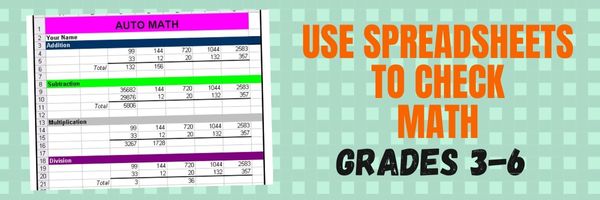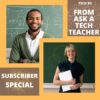
Year: 2023
Is ChatGPT Writing Your Students’ Homework? New Tech Will Detect It
The hottest disruptive technology to come to education since iPads is ChatGPT. It sounds too simple when I read the dozens of articles that fill the internet so I asked the AI to tell me what it was:
“ChatGPT is a computer program that generates text based on what you type to it. It uses advanced language processing to understand your prompt and respond with relevant, coherent text. You can talk to ChatGPT like you would with a person, and it will generate text that sounds similar to human writing. ChatGPT can be used for a variety of text-based tasks such as having a conversation, answering questions, writing content, and more.”
That is so human-like, it’s scary. So as a teacher, how will you know if an AI is doing student homework? Check out what Ask a Tech Teacher contributor and technology expert, Jodi Williams, has to say about ChatGPT:
Is ChatGPT Writing Your Students’ Homework? A New Technology Will Be Able to Detect It
It has been unthinkable for decades to suspect that artificial intelligence could write your students’ homework, yet it appears to be true with the famous ChatGPT bot. Since it’s relatively easy for a college professor to detect cases of plagiarism manually, it’s much safer when you can represent some proof that a student has used AI-generated writing for an assignment. The good news is that we have a technology that is able to detect it. Currently, Turnitin is able to implement a specific technology that will analyze what has been written and checked in terms of originality and machine learning algorithms. Although artificial technology is always getting better and more cryptic, the tools that are used by Turnitin are also evolving, thus allowing college professors to do the checking and save valuable time.
TurnItIn Has The Grip On ChatGPT Artificial Writing Tool
The use of TurnItIn provides educators with a great opportunity to get things checked. While it is a commercial tool, it does not reveal the specifics of how things work, yet it uses AI-based technology against machine learning algorithms used by the ChatGPT tool. Now, if you are feeling stuck and need help with writing, it’s much safer to use a plagiarism free essay writing service and discuss your concerns with the trained experts who can assist you in completing your work in a legit way. Sometimes you need just a bit of human assistance to understand the objectives and overcome writer’s block, among other things. Most importantly, it’s a legit way to avoid plagiarism and learn how to analyze and process information.
Highlighted Parts.
If locating the parts in question sounds problematic, TurnItIn will also highlight the odd sections with different colors and offer an intelligent search through the Internet to see whether some parts have been copied. The combination of both will help to be sure that there are no false alerts. Some students will also use tools like Google Translate, yet it’s a different matter and not a case of plagiarism. If you know a foreign exchange student, suggest dealing with TheWordPoint service instead to approach things correctly when some grammar and structure correction must be done. It will help to avoid trouble and the possible false alerts that AI-based tools may detect.
Analytical Reports.
The best part about detecting ChatGPT with TurnItIn is the presence of built-in analytical tools that will help you to check the report and confront the student if there is a clear denial stage. If a student claims that no ChatGPT has been used, ask for a revision and see if it maintains the same style. Of course, if you see drastic changes, one can assume that other AI tools might have been used, yet it is not always the fact! Use analytical reports and try to do your best to maintain contact with a student!
The Dangers of ChatGPT in Practice
While there are evident dangers like plagiarism and academic misconduct, it also brings modern students into an abyss of chaos as artificial intelligence technology is not able to understand the text that is being generated. Since most learners do not proofread or edit what’s being generated, it becomes easy for educators to see that an assignment does not make sense. Ultimately, it’s not only the time wasted but an academic future that becomes even vaguer. Therefore, using tools like ChatGPT is dangerous as it doesn’t teach you anything and cannot even be considered a form of cheating per se because it’s way worse than that!
BIO
Jodi Williams is a technology expert passionate about learning and innovative teaching methods. She loves to share bright ideas and her discoveries in writing. Follow Jodi to learn new things and find inspiration.
–image credit Deposit Photos
Copyright ©2023 askatechteacher.com – All rights reserved.

@turnitin
#chatgpt #aieducation
Jacqui Murray has been teaching K-18 technology for 30 years. She is the editor/author of over a hundred tech ed resources including a K-12 technology curriculum, K-8 keyboard curriculum, K-8 Digital Citizenship curriculum. She is an adjunct professor in tech ed, Master Teacher, webmaster for four blogs, an Amazon Vine Voice, CSTA presentation reviewer, freelance journalist on tech ed topics, and author of the tech thrillers, To Hunt a Sub and Twenty-four Days. You can find her resources at Structured Learning.
Share this:
- Click to share on Facebook (Opens in new window) Facebook
- Click to share on X (Opens in new window) X
- Click to share on LinkedIn (Opens in new window) LinkedIn
- Click to share on Pinterest (Opens in new window) Pinterest
- Click to share on Telegram (Opens in new window) Telegram
- Click to email a link to a friend (Opens in new window) Email
- More
#72: Check Your Math in Excel
This is one of the most popular lessons I teach to Excel beginners. It is relevant, instantly usable and makes sense from the beginning. Click the images below to enlarge them for viewing.
[gallery columns="2" ids="45219,45218"]–from 55 Technology Projects for the Digital Classroom
Copyright ©2023 usna.wordpress.com – All rights reserved.

Jacqui Murray has been teaching K-18 technology for 30 years. She is the editor/author of over a hundred tech ed resources including a K-12 technology curriculum, K-8 keyboard curriculum, K-8 Digital Citizenship curriculum. She is an adjunct professor in tech ed, Master Teacher, webmaster for four blogs, an Amazon Vine Voice, CSTA presentation reviewer, freelance journalist on tech ed topics, and author of the tech thrillers, To Hunt a Sub and Twenty-four Days. You can find her resources at Structured Learning.
Share this:
- Click to share on Facebook (Opens in new window) Facebook
- Click to share on X (Opens in new window) X
- Click to share on LinkedIn (Opens in new window) LinkedIn
- Click to share on Pinterest (Opens in new window) Pinterest
- Click to share on Telegram (Opens in new window) Telegram
- Click to email a link to a friend (Opens in new window) Email
- More
Use Tech to Teach Languages
Every year, the world grows smaller, making the importance of language learning greater. Ask a Tech Teacher contributor, Roman Zhidkov, has interesting ideas on easy ways to learn a new language using already-available online technology:
How to Use Tech for Language Learning
As an educator, I’m always looking for ways to facilitate learning through technology. In the language learning field, tech has been transformative in enabling learners to master languages from home, particularly in recent years with the pandemic. In this article, we will explore some of the most effective ways to use technology for learning languages.
Learning a new language can be a challenging and time-consuming task, but technology can make it more accessible, easier and more efficient. There are many tools available that can help educators and students alike to make the most of their language-learning experience.
Flashcards are a tool used by many language learners. There are dozens of apps available that allow you to create and use flashcards to learn new words and phrases. They apply a concept called spaced repetition: an algorithm recognises how well you know each word/flashcard, then prioritizes them so that you study the things you don’t know, without wasting precious time on the things you already do. These apps often allow you to create your own flashcards or use pre-made ones, and they also typically have a feature that allows you to track your progress. One popular and free flashcard app worth trying is Quizlet.
Another learning method that has exploded in popularity since 2020 is online language classes. These are made possible by video calling tools, which are either embedded in the learning platforms, or linked to from those platforms (e.g. Zoom, Skype etc.) These tools allow you to have live, interactive lessons that are just as effective as in-person classes. They also provide the added benefit of being able to schedule lessons at any time and from any location. This reduces costs as the tutor doesn’t need to travel. In my experience, the quality of online language tutors varies considerably, so look for a platform that has a rigorous application process.
Share this:
- Click to share on Facebook (Opens in new window) Facebook
- Click to share on X (Opens in new window) X
- Click to share on LinkedIn (Opens in new window) LinkedIn
- Click to share on Pinterest (Opens in new window) Pinterest
- Click to share on Telegram (Opens in new window) Telegram
- Click to email a link to a friend (Opens in new window) Email
- More
Tech Tip #55 Find a Lost Shortcut
 In these 169 tech-centric situations, you get an overview of pedagogy—the tech topics most important to your teaching—as well as practical strategies to address most classroom tech situations, how to scaffold these to learning, and where they provide the subtext to daily tech-infused education.
In these 169 tech-centric situations, you get an overview of pedagogy—the tech topics most important to your teaching—as well as practical strategies to address most classroom tech situations, how to scaffold these to learning, and where they provide the subtext to daily tech-infused education.
Today’s tip: How to find a lots shortcut
Category: Problem-solving
Q: I can’t find the shortcut for a program I want to open. It’s not on the desktop, the start menu or in ‘all programs’. How do I open the program?
A: PC’s: Click the ‘Start button’, then type the program name where it says ‘search’ to get the shortcut.
iPads: Swipe down from the top with one finger and type the program name in the search bar.
For Chromebooks: Look in Apps or on the Chromebook Shelf at the bottom of the device. Or, use Alt+Shift+M to open the File Manager.
Sign up for a new tip each week or buy the entire 169 Real-world Ways to Put Tech into Your Classroom.
What’s your favorite tech tip in your classroom? Share it in the comments below.
Share this:
- Click to share on Facebook (Opens in new window) Facebook
- Click to share on X (Opens in new window) X
- Click to share on LinkedIn (Opens in new window) LinkedIn
- Click to share on Pinterest (Opens in new window) Pinterest
- Click to share on Telegram (Opens in new window) Telegram
- Click to email a link to a friend (Opens in new window) Email
- More
Photoshop Basics
Before teaching Lesson Plans using Photoshop, be sure to cover the basics with students:
Open Photoshop. Notice the tool bars at the top. These will change depending upon the tool you choose from the left side. These are the crux of Photoshop. We’ll cover about ten of them in fifth grade. The rest will have to wait. The right-hand tools are used independent of the left-hand tools. They are more project oriented.
- Click the File Browser tool (top right-ish). It shows you the folders on your computer. From here, you can select the picture you’d like to edit (or use File-open) (more…)
Share this:
- Click to share on Facebook (Opens in new window) Facebook
- Click to share on X (Opens in new window) X
- Click to share on LinkedIn (Opens in new window) LinkedIn
- Click to share on Pinterest (Opens in new window) Pinterest
- Click to share on Telegram (Opens in new window) Telegram
- Click to email a link to a friend (Opens in new window) Email
- More
14 Tech Assessment Strategies
It used to be simple to post grades. Add up test scores and see what the student earned. Very defensible. Everyone understood. It’s not that way anymore. Here are factors I consider when I’m posting grades for my tech students:
- Does s/he remember skills from prior lessons as they complete current lessons?
- Does s/he show evidence of learning by using tech class knowledge in classroom or home?
- Does s/he participate in class discussions?
- Does s/he complete daily goals (a project, visit a website, watch a tutorial, etc.)?
- Does s/he save to their network folder?
Share this:
- Click to share on Facebook (Opens in new window) Facebook
- Click to share on X (Opens in new window) X
- Click to share on LinkedIn (Opens in new window) LinkedIn
- Click to share on Pinterest (Opens in new window) Pinterest
- Click to share on Telegram (Opens in new window) Telegram
- Click to email a link to a friend (Opens in new window) Email
- More
Tech Professions Students Should Consider
Tech industry has been working solidly for the last decade or so and promises the best careers to students. Our Ask a Tech Teacher contributor has a short list of professions that students can look forward to:
The Future of the Tech Industry: What Professions Should Students Look Into?
Technologies like artificial intelligence (AI), machine learning and cloud computing are transforming businesses. Demand has grown for individuals with the knowledge and skills to meet their needs. Universities are offering various undergraduate and postgraduate degree programs to prepare students for the future. Students can’t go wrong with future careers in information technology and computer science. These careers have the most job offers and acceptance rates. This is particularly the case for students with advanced degrees. What are some of the best tech jobs for the future?
Machine learning engineer
One of the best technology jobs of the future is as a machine learning engineer. Machine learning engineers have been ranked as one of the fastest-growing jobs in the United States. Machine learning is a branch of AI that uses big data to create algorithms. These algorithms can program a machine like a digital voice assistant or a self-driving car. They can perform and carry out tasks like humans. The machine can continue to learn and improve without any interference from humans. Natural language processing and image recognition are ways in which the machine learns.
To become a machine learning engineer, you will need a master’s degree in computer science or artificial intelligence. This will give you an in-depth understanding of topics like natural language technology and computational intelligence. You will need this for the need for a career in this field.
Share this:
- Click to share on Facebook (Opens in new window) Facebook
- Click to share on X (Opens in new window) X
- Click to share on LinkedIn (Opens in new window) LinkedIn
- Click to share on Pinterest (Opens in new window) Pinterest
- Click to share on Telegram (Opens in new window) Telegram
- Click to email a link to a friend (Opens in new window) Email
- More
Groundhog Day and the 100th Day of School
Here are some activities for Groundhog Day–February 2nd:
- Fun Facts About Groundhogs–video
- Groundhog Day Digital Activities–grades 3-5
- Groundhog Day for Kids–a video
- Groundhog Day Games
- Groundhog Day Teaching Resources
- History of Groundhog Day–from History.com
- Punxsutawney Groundhog Club Website
- Why Groundhogs Supposedly Predict the Weather–video
If this is the 100th day of school, here are resources for that:
Share this:
- Click to share on Facebook (Opens in new window) Facebook
- Click to share on X (Opens in new window) X
- Click to share on LinkedIn (Opens in new window) LinkedIn
- Click to share on Pinterest (Opens in new window) Pinterest
- Click to share on Telegram (Opens in new window) Telegram
- Click to email a link to a friend (Opens in new window) Email
- More
#WorldReadAloudDay February 1st
On Feb. 1st, World Read Aloud Day celebrates the pure joy of oral reading with kids of all ages. Created by LitWorld, past years have found over 1 million people in 100 countries joining together to enjoy the power and wonder of reading aloud in groups or individually, at school or home, and discovering what it means to listen to a story told through the voice of another. For many, this is a rare opportunity to hear the passion of a well-told story and fall in love with tales where hearing them reaches listeners on a level nothing else can. Think back to your experiences. You probably sat with an adult, in their lap or curled up in bed. The way they mimicked the voices in the story, built drama, and enthused with you over the story and characters made you want to read more stories like that on your own. This is a favorite activity not just for pre-readers, but beginning and accomplished readers because it’s not about reading the book; it’s about experiencing it through the eyes of a storyteller.
Somehow, as lives for both the adults and children have gotten busier, as digital devices have taken over, as parents turned to TVs or iPads to babysit kids while they do something else, we’ve gotten away from this most companionable of activities. World Read Aloud Day is an opportunity to get back to it.
Importance of reading aloud
There is no more powerful way to develop a love of reading than being read to. Hearing pronunciations, decoding words in context, experiencing the development and completion of a well-plotted story as though you were there are reason enough to read aloud but there’s more. Reading in general and reading aloud specifically is positively correlated to literacy and success in school. It builds foundational learning skills, introduces and reinforces vocabulary, and provides a joyful activity that’s mostly free, cooperative, and often collaborative. Did you know reading aloud:
Share this:
- Click to share on Facebook (Opens in new window) Facebook
- Click to share on X (Opens in new window) X
- Click to share on LinkedIn (Opens in new window) LinkedIn
- Click to share on Pinterest (Opens in new window) Pinterest
- Click to share on Telegram (Opens in new window) Telegram
- Click to email a link to a friend (Opens in new window) Email
- More
Subscriber Special: Common Core Math Lessons
Every month, subscribers to our newsletter get a free/discounted resource to help their tech teaching.
Common Core–Math Lesson Plans
160 pages, 20 projects, over 114 Common Core standards, for 9 grades (K-8).
On sale until February 4, 2023
How to Achieve Common Core with Tech is a four-volume series that focuses on using technology to meet Common Core standards in Language, Writing, Reading, Speaking/Listening (not yet available), and Math.
This volume–Math–on sale this week–includes 20 projects and 114 Common Core Standards for K-8, each showing how technology makes achieving Common Core math standards intuitive, time-saving, and exciting for students with a natural love of all things digital. Each lesson includes:
- Common Core standards addressed
- NETS-S Standards addressed
- Vocabulary used
- Time Required
- Grade level recommended and suggested background
- Essential Question
- Big Idea
- Materials required and teacher preparation
- Step-by-step directions
- Help with tech problems
- Extensions—how to differentiate and dig deeper
A note: These books are not intended to teach Common Core Standards. What these books show is how to use technology to teach.
- Digital: 160 pages
- Publisher: Structured Learning
- Language: English
- ISBN: 978-0-9893690-3-9
Curious? Here’s a preview:
Copyright ©2023 usna.wordpress.com – All rights reserved.

Jacqui Murray has been teaching K-18 technology for 30 years. She is the editor/author of over a hundred tech ed resources including a K-12 technology curriculum, K-8 keyboard curriculum, K-8 Digital Citizenship curriculum. She is an adjunct professor in tech ed, Master Teacher, webmaster for four blogs, an Amazon Vine Voice, CSTA presentation reviewer, freelance journalist on tech ed topics, and author of the tech thrillers, To Hunt a Sub and Twenty-four Days. You can find her resources at Structured Learning.
Share this:
- Click to share on Facebook (Opens in new window) Facebook
- Click to share on X (Opens in new window) X
- Click to share on LinkedIn (Opens in new window) LinkedIn
- Click to share on Pinterest (Opens in new window) Pinterest
- Click to share on Telegram (Opens in new window) Telegram
- Click to email a link to a friend (Opens in new window) Email
- More




















































